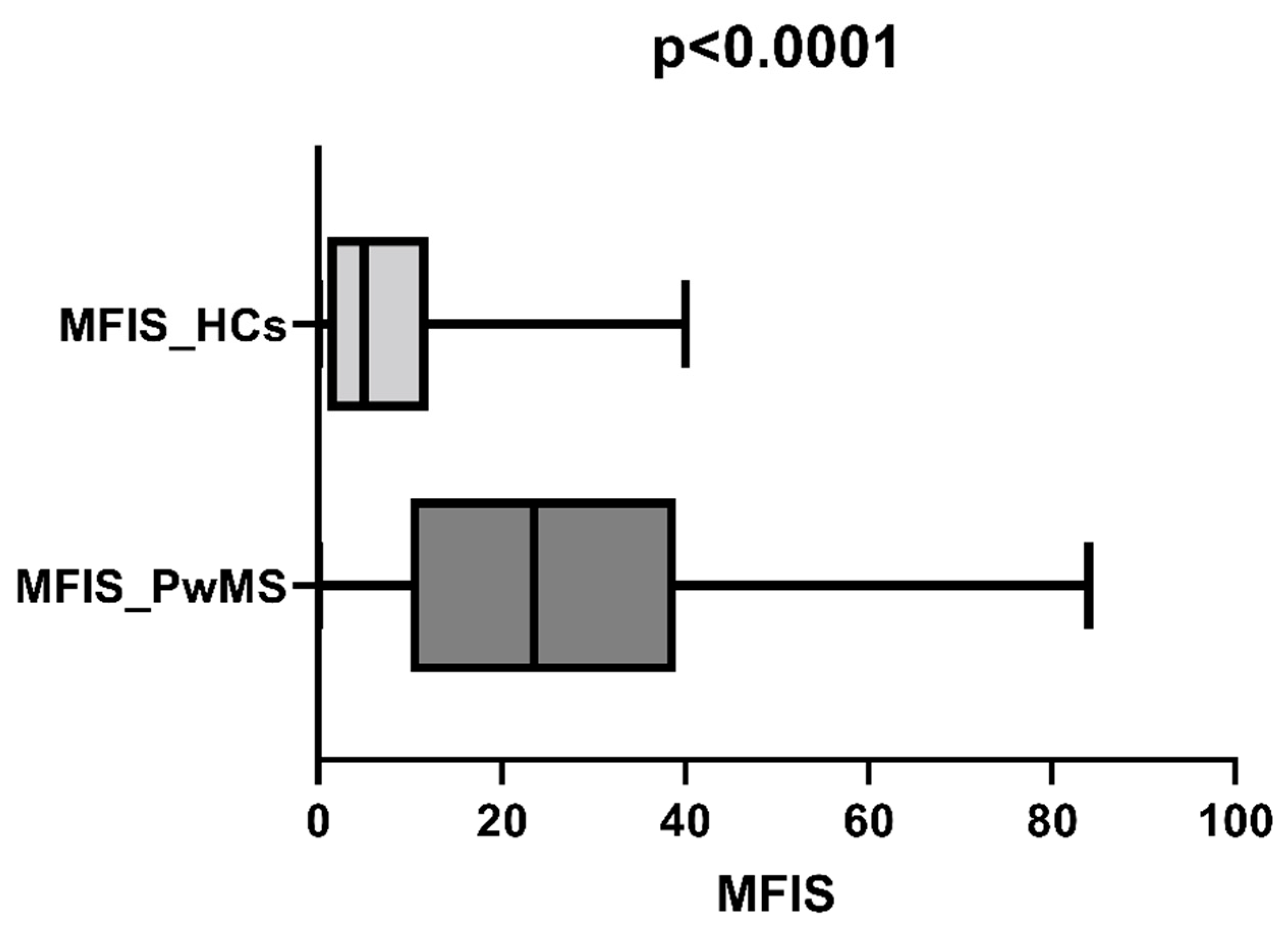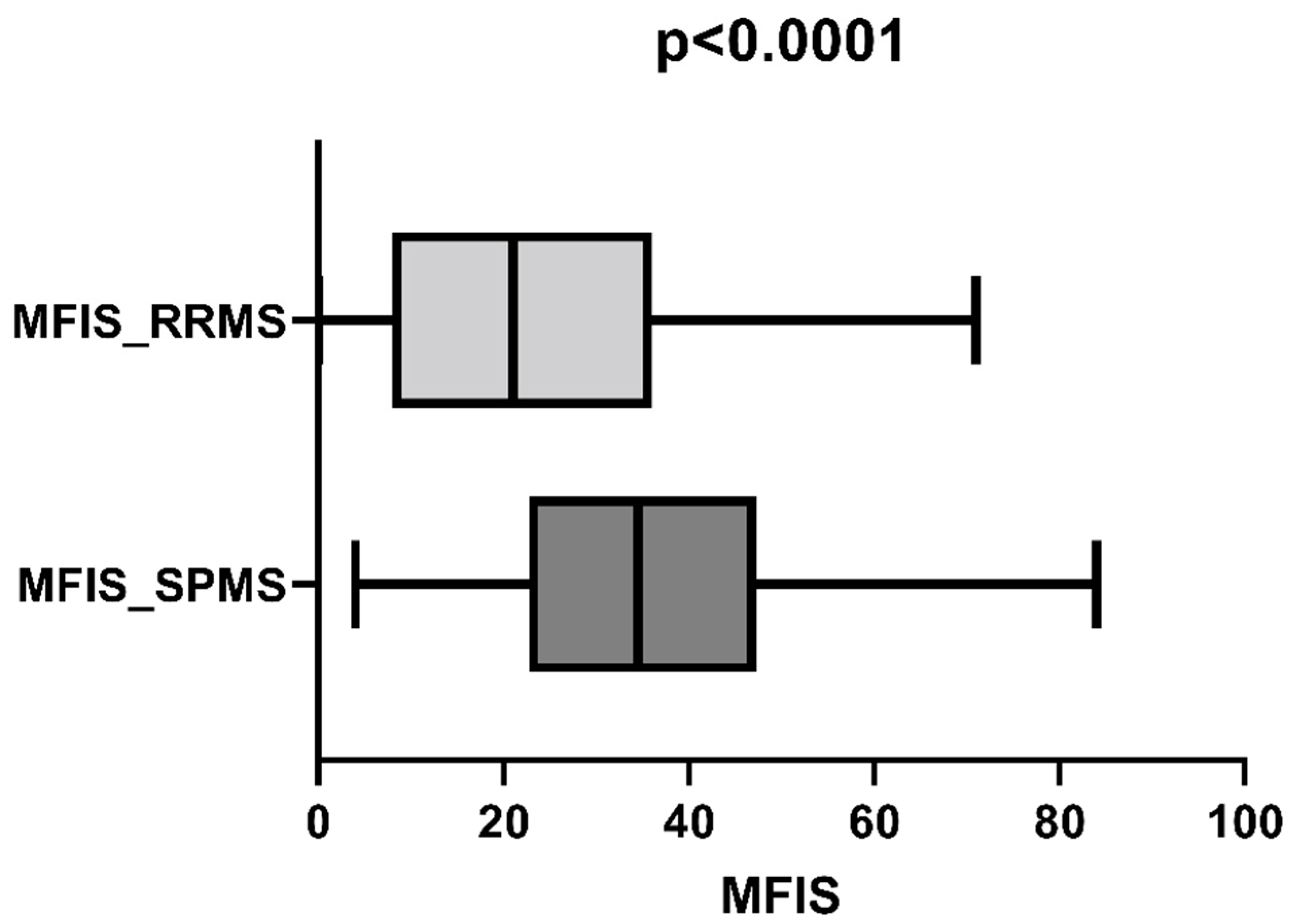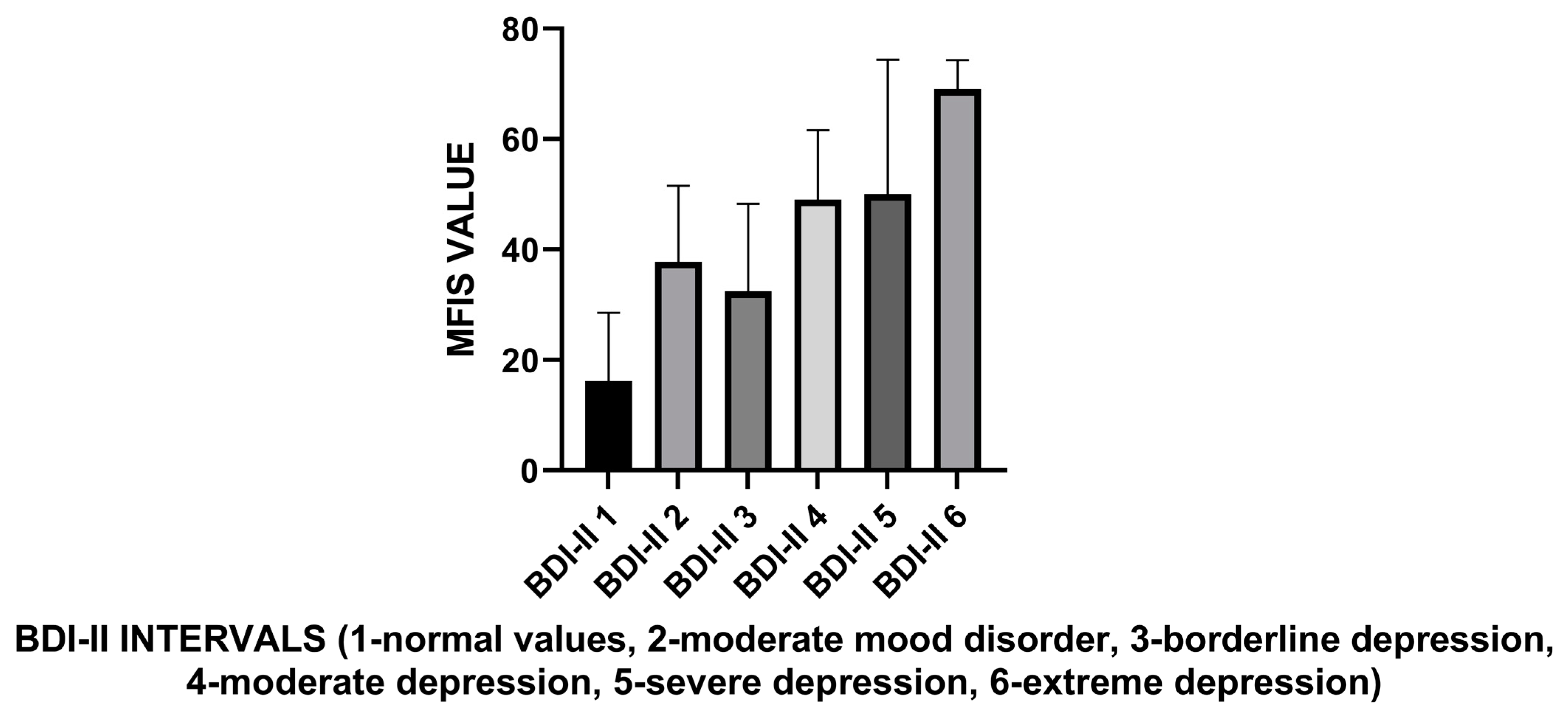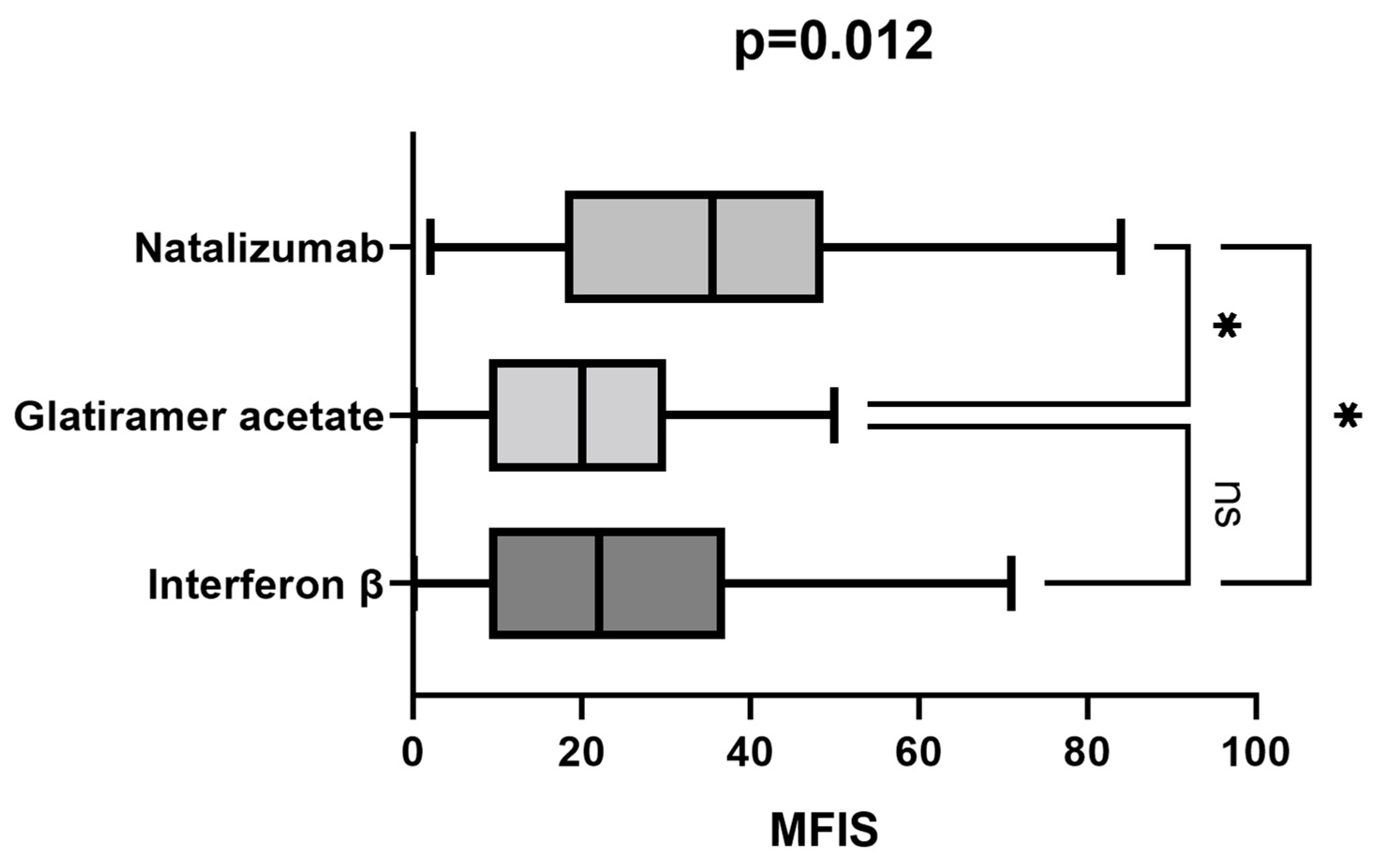Sociodemographic and Clinical Determinants of Fatigue in Multiple Sclerosis
Abstract
:1. Introduction
2. Materials and Methods
Statistical Analysis
3. Results
3.1. Demographical and Clinical Data of the Patient and Control Groups
3.2. Modified Fatigue Impact Scale in Patient and Control Groups
3.3. Relationship between Demographic and Disease-Related Factors and Fatigue
3.4. Fatigue Level in MS Subgroups
3.5. Relationship between Fatigue Level and Depression
3.6. Associations between Fatigue and Demographic and Disease-Related Data in the PwMS
3.7. Analysis of Modified Fatigue Impact Scale Subscales
3.8. Modified Fatigue Impact Scale in Treatment Groups
4. Discussion
5. Conclusions
Author Contributions
Funding
Institutional Review Board Statement
Informed Consent Statement
Data Availability Statement
Conflicts of Interest
References
- Balasa, R.; Barcutean, L.; Balasa, A.; Motataianu, A.; Roman-Filip, C.; Manu, D. The Action of TH17 Cells on Blood Brain Barrier in Multiple Sclerosis and Experimental Autoimmune Encephalomyelitis. Hum. Immunol. 2020, 81, 237–243. [Google Scholar] [CrossRef]
- Balasa, R.; Barcutean, L.; Mosora, O.; Manu, D. Reviewing the Significance of Blood-Brain Barrier Disruption in Multiple Sclerosis Pathology and Treatment. Int. J. Mol. Sci. 2021, 22, 8370. [Google Scholar] [CrossRef]
- Braley, T.J.; Chervin, R.D. Fatigue in Multiple Sclerosis: Mechanisms, Evaluation, and Treatment. Sleep 2010, 33, 1061–1067. [Google Scholar] [CrossRef]
- Lublin, F.D.; Reingold, S.C.; Cohen, J.A.; Cutter, G.R.; Sørensen, P.S.; Thompson, A.J.; Wolinsky, J.S.; Balcer, L.J.; Banwell, B.; Barkhof, F.; et al. Defining the Clinical Course of Multiple Sclerosis: The 2013 Revisions. Neurology 2014, 83, 278–286. [Google Scholar] [CrossRef]
- Maier, S.; Barcutean, L.; Andone, S.; Manu, D.; Sarmasan, E.; Bajko, Z.; Balasa, R. Recent Progress in the Identification of Early Transition Biomarkers from Relapsing-Remitting to Progressive Multiple Sclerosis. Int. J. Mol. Sci. 2023, 24, 4375. [Google Scholar] [CrossRef] [PubMed]
- Maier, S.; Buruian, M.; Maier, A.; Moţăţăianu, A.; Voidăzan, S.; Bajkó, Z.; Bălaşa, R. The Determinants of Depression in a Romanian Cohort of Multiple Sclerosis Patients. Acta Neurol. Belg. 2016, 116, 135–143. [Google Scholar] [CrossRef] [PubMed]
- Maier, S.; Balasa, R.; Buruian, M.; Maier, A.; Bajko, Z. Depression in Multiple Sclerosis-Review. Rom. J. Neurol. 2015, 14, 22–29. [Google Scholar] [CrossRef]
- Guidelines, M.S.C.P. Fatigue and Multiple Sclerosis: Evidence-Based Management Strategies for Fatigue in Multiple Sclerosis; Paralyzed Veterans of America: Washington, DC, USA, 1998. [Google Scholar]
- Ayache, S.S.; Serratrice, N.; Lahoud, G.N.A.; Chalah, M.A. Fatigue in Multiple Sclerosis: A Review of the Exploratory and Therapeutic Potential of Non-Invasive Brain Stimulation. Front. Neurol. 2022, 13, 813965. [Google Scholar] [CrossRef]
- Mills, R.J.; Young, C.A. A Medical Definition of Fatigue in Multiple Sclerosis. QJM 2008, 101, 49–60. [Google Scholar] [CrossRef]
- Krupp, L.B.; Alvarez, L.A.; LaRocca, N.G.; Scheinberg, L.C. Fatigue in Multiple Sclerosis. Arch. Neurol. 1988, 45, 435–437. [Google Scholar] [CrossRef]
- Krupp, L. Fatigue Is Intrinsic to Multiple Sclerosis (MS) and Is the Most Commonly Reported Symptom of the Disease. Mult. Scler. 2006, 12, 367–368. [Google Scholar] [CrossRef]
- Janardhan, V.; Bakshi, R. Quality of Life in Patients with Multiple Sclerosis: The Impact of Fatigue and Depression. J. Neurol. Sci. 2002, 205, 51–58. [Google Scholar] [CrossRef]
- Smith, M.M.; Arnett, P.A. Factors Related to Employment Status Changes in Individuals with Multiple Sclerosis. Mult. Scler. 2005, 11, 602–609. [Google Scholar] [CrossRef] [PubMed]
- Giovannoni, G. Multiple Sclerosis Related Fatigue. J. Neurol. Neurosurg. Psychiatry 2006, 77, 2–3. [Google Scholar] [CrossRef]
- Freal, J.E.; Kraft, G.H.; Coryell, J.K. Symptomatic Fatigue in Multiple Sclerosis. Arch. Phys. Med. Rehabil. 1984, 65, 135–138. [Google Scholar] [PubMed]
- Fisk, J.D.; Pontefract, A.; Ritvo, P.G.; Archibald, C.J.; Murray, T.J. The Impact of Fatigue on Patients with Multiple Sclerosis. Can. J. Neurol. Sci. 1994, 21, 9–14. [Google Scholar] [CrossRef]
- Thompson, A.J.; Banwell, B.L.; Barkhof, F.; Carroll, W.M.; Coetzee, T.; Comi, G.; Correale, J.; Fazekas, F.; Filippi, M.; Freedman, M.S.; et al. Diagnosis of Multiple Sclerosis: 2017 Revisions of the McDonald Criteria. Lancet Neurol. 2018, 17, 162–173. [Google Scholar] [CrossRef]
- Kurtzke, J.F. Rating Neurologic Impairment in Multiple Sclerosis: An Expanded Disability Status Scale (EDSS). Neurology 1983, 33, 1444–1452. [Google Scholar] [CrossRef]
- Ritvo, P.G.; Fischer, J.S.; Miller, D.M.; Andrews, H.; Paty, D.W.; LaRocca, N.G. MSQLI: Multiple Sclerosis Quality of Life Inventory: A User’s Manual; National Multiple Sclerosis Society: New York, NY, USA, 1997; pp. 1–65. [Google Scholar]
- Beck, A.T.; Ward, C.H.; Mendelson, M.; Mock, J.; Erbaugh, J. An Inventory for Measuring Depression. Arch. Gen. Psychiatry 1961, 4, 561–571. [Google Scholar] [CrossRef] [PubMed]
- Benedict, R.H.; DeLuca, J.; Phillips, G.; LaRocca, N.; Hudson, L.D.; Rudick, R. Multiple Sclerosis Outcome Assessments Consortium. Validity of the Symbol Digit Modalities Test as a Cognition Performance Outcome Measure for Multiple Sclerosis. Mult. Scler. 2017, 23, 721–733. [Google Scholar] [CrossRef]
- Kos, D.; Kerckhofs, E.; Nagels, G.; D’hooghe, M.B.; Ilsbroukx, S. Origin of Fatigue in Multiple Sclerosis: Review of the Literature. Neurorehabilit. Neural Repair. 2008, 22, 91–100. [Google Scholar] [CrossRef] [PubMed]
- Sharief, M.K.; Hentges, R. Association between Tumor Necrosis Factor-Alpha and Disease Progression in Patients with Multiple Sclerosis. N. Engl. J. Med. 1991, 325, 467–472. [Google Scholar] [CrossRef]
- Heesen, C.; Nawrath, L.; Reich, C.; Bauer, N.; Schulz, K.-H.; Gold, S.M. Fatigue in Multiple Sclerosis: An Example of Cytokine Mediated Sickness Behaviour? J. Neurol. Neurosurg. Psychiatry 2006, 77, 34–39. [Google Scholar] [CrossRef] [PubMed]
- Hirsch, R.L.; Panitch, H.S.; Johnson, K.P. Lymphocytes from Multiple Sclerosis Patients Produce Elevated Levels of Gamma Interferon In Vitro. J. Clin. Immunol. 1985, 5, 386–389. [Google Scholar] [CrossRef]
- Téllez, N.; Comabella, M.; Julià, E.; Río, J.; Tintoré, M.; Brieva, L.; Nos, C.; Montalban, X. Fatigue in Progressive Multiple Sclerosis Is Associated with Low Levels of Dehydroepiandrosterone. Mult. Scler. 2006, 12, 487–494. [Google Scholar] [CrossRef] [PubMed]
- Bol, Y.; Duits, A.A.; Hupperts, R.M.M.; Vlaeyen, J.W.S.; Verhey, F.R.J. The Psychology of Fatigue in Patients with Multiple Sclerosis: A Review. J. Psychosom. Res. 2009, 66, 3–11. [Google Scholar] [CrossRef]
- Roelcke, U.; Kappos, L.; Lechner-Scott, J.; Brunnschweiler, H.; Huber, S.; Ammann, W.; Plohmann, A.; Dellas, S.; Maguire, R.P.; Missimer, J.; et al. Reduced Glucose Metabolism in the Frontal Cortex and Basal Ganglia of Multiple Sclerosis Patients with Fatigue: A 18F-Fluorodeoxyglucose Positron Emission Tomography Study. Neurology 1997, 48, 1566–1571. [Google Scholar] [CrossRef]
- Tartaglia, M.C.; Narayanan, S.; Arnold, D.L. Mental Fatigue Alters the Pattern and Increases the Volume of Cerebral Activation Required for a Motor Task in Multiple Sclerosis Patients with Fatigue. Eur. J. Neurol. 2008, 15, 413–419. [Google Scholar] [CrossRef]
- Ford, H.; Trigwell, P.; Johnson, M. The Nature of Fatigue in Multiple Sclerosis. J. Psychosom. Res. 1998, 45, 33–38. [Google Scholar] [CrossRef]
- Trojan, D.A.; Arnold, D.; Collet, J.-P.; Shapiro, S.; Bar-Or, A.; Robinson, A.; Le Cruguel, J.-P.; Ducruet, T.; Narayanan, S.; Arcelin, K.; et al. Fatigue in Multiple Sclerosis: Association with Disease-Related, Behavioural and Psychosocial Factors. Mult. Scler. 2007, 13, 985–995. [Google Scholar] [CrossRef] [PubMed]
- Coyle, P.K. What Can We Learn from Sex Differences in MS? J. Pers. Med. 2021, 11, 1006. [Google Scholar] [CrossRef]
- Anens, E.; Emtner, M.; Zetterberg, L.; Hellström, K. Physical Activity in Subjects with Multiple Sclerosis with Focus on Gender Differences: A Survey. BMC Neurol. 2014, 14, 47. [Google Scholar] [CrossRef]
- Weiland, T.J.; Jelinek, G.A.; Marck, C.H.; Hadgkiss, E.J.; van der Meer, D.M.; Pereira, N.G.; Taylor, K.L. Clinically Significant Fatigue: Prevalence and Associated Factors in an International Sample of Adults with Multiple Sclerosis Recruited via the Internet. PLoS ONE 2015, 10, e0115541. [Google Scholar] [CrossRef]
- Kroencke, D.C.; Lynch, S.G.; Denney, D.R. Fatigue in Multiple Sclerosis: Relationship to Depression, Disability, and Disease Pattern. Mult. Scler. 2000, 6, 131–136. [Google Scholar] [CrossRef]
- Pittion-Vouyovitch, S.; Debouverie, M.; Guillemin, F.; Vandenberghe, N.; Anxionnat, R.; Vespignani, H. Fatigue in Multiple Sclerosis Is Related to Disability, Depression and Quality of Life. J. Neurol. Sci. 2006, 243, 39–45. [Google Scholar] [CrossRef] [PubMed]
- Bergamaschi, R.; Romani, A.; Versino, M.; Poli, R.; Cosi, V. Clinical Aspects of Fatigue in Multiple Sclerosis. Funct. Neurol. 1997, 12, 247–251. [Google Scholar] [PubMed]
- Flachenecker, P.; Kümpfel, T.; Kallmann, B.; Gottschalk, M.; Grauer, O.; Rieckmann, P.; Trenkwalder, C.; Toyka, K.V. Fatigue in Multiple Sclerosis: A Comparison of Different Rating Scales and Correlation to Clinical Parameters. Mult. Scler. 2002, 8, 523–526. [Google Scholar] [CrossRef]
- Bakshi, R.; Shaikh, Z.A.; Miletich, R.S.; Czarnecki, D.; Dmochowski, J.; Henschel, K.; Janardhan, V.; Dubey, N.; Kinkel, P.R. Fatigue in Multiple Sclerosis and Its Relationship to Depression and Neurologic Disability. Mult. Scler. 2000, 6, 181–185. [Google Scholar] [CrossRef]
- Andreasen, A.K.; Iversen, P.; Marstrand, L.; Siersma, V.; Siebner, H.R.; Sellebjerg, F. Structural and Cognitive Correlates of Fatigue in Progressive Multiple Sclerosis. Neurol. Res. 2019, 41, 168–176. [Google Scholar] [CrossRef]
- Diamond, B.J.; Johnson, S.K.; Kaufman, M.; Graves, L. Relationships between Information Processing, Depression, Fatigue and Cognition in Multiple Sclerosis. Arch. Clin. Neuropsychol. 2008, 23, 189–199. [Google Scholar] [CrossRef] [PubMed]
- Heesen, C.; Schulz, K.H.; Fiehler, J.; Von der Mark, U.; Otte, C.; Jung, R.; Poettgen, J.; Krieger, T.; Gold, S.M. Correlates of Cognitive Dysfunction in Multiple Sclerosis. Brain Behav. Immun. 2010, 24, 1148–1155. [Google Scholar] [CrossRef] [PubMed]
- Pokryszko-Dragan, A.; Zagrajek, M.; Slotwinski, K.; Bilinska, M.; Gruszka, E.; Podemski, R. Event-Related Potentials and Cognitive Performance in Multiple Sclerosis Patients with Fatigue. Neurol. Sci. 2016, 37, 1545–1556. [Google Scholar] [CrossRef]
- Holtzer, R.; Foley, F. The Relationship between Subjective Reports of Fatigue and Executive Control in Multiple Sclerosis. J. Neurol. Sci. 2009, 281, 46–50. [Google Scholar] [CrossRef]
- Asano, M.; Finlayson, M.L. Meta-Analysis of Three Different Types of Fatigue Management Interventions for People with Multiple Sclerosis: Exercise, Education, and Medication. Mult. Scler. Int. 2014, 2014, 798285. [Google Scholar] [CrossRef] [PubMed]
- Sangelaji, B.; Nabavi, S.M.; Estebsari, F.; Banshi, M.R.; Rashidian, H.; Jamshidi, E.; Dastoorpour, M. Effect of Combination Exercise Therapy on Walking Distance, Postural Balance, Fatigue and Quality of Life in Multiple Sclerosis Patients: A Clinical Trial Study. Iran. Red. Crescent Med. J. 2014, 16, e17173. [Google Scholar] [CrossRef] [PubMed]
- Carter, A.; Daley, A.; Humphreys, L.; Snowdon, N.; Woodroofe, N.; Petty, J.; Roalfe, A.; Tosh, J.; Sharrack, B.; Saxton, J.M. Pragmatic Intervention for Increasing Self-Directed Exercise Behaviour and Improving Important Health Outcomes in People with Multiple Sclerosis: A Randomised Controlled Trial. Mult. Scler. 2014, 20, 1112–1122. [Google Scholar] [CrossRef] [PubMed]
- Grossman, P.; Kappos, L.; Gensicke, H.; D’Souza, M.; Mohr, D.C.; Penner, I.K.; Steiner, C. MS Quality of Life, Depression, and Fatigue Improve after Mindfulness Training: A Randomized Trial. Neurology 2010, 75, 1141–1149. [Google Scholar] [CrossRef]
- Bringeland, G.H.; Myhr, K.-M.; Vedeler, C.A.; Gavasso, S. Wearing-off at the End of Natalizumab Dosing Interval and Risk of MS Disease Activity: A Prospective 1-Year Follow-up Study. J. Neurol. Sci. 2020, 415, 116880. [Google Scholar] [CrossRef]




| PwMS N = 150 | HCs N = 100 | Statistical Significance | |
|---|---|---|---|
| Current age (Mean ± SD) | 42.32 ± 9.66 | 41.53 ± 12.17 | NS |
| Gender (Male/Female) | 53:97 | 41:59 | NS |
| Age at disease onset (Mean ± SD) | 31.56 ± 8.75 | NA | |
| Duration of the disease—years (Mean ± SD) | 10.85 ± 6.44 | NA | |
| Annual relapse rate—last year (Mean ± SD) | 0.58 ± 1.06 | NA | |
| MS Form (RRMS:SPMS) | 116:34 | NA | |
| EDSS (Mean ± SD) | 2.87 ± 1.97 | NA | |
| BDI-II (Mean ± SD) | 10.6 ± 9.7 | 4.56 ± 4.31 | p < 0.0001 |
| MFIS total score (Mean ± SD) | 26.22 ± 18.69 | 8.02 ± 9.16 | p = 0.0001 |
| MFIS-Physical subscale (Mean ± SD) | 15.21 ± 9.74 | 4.68 ± 5.43 | p < 0.0001 |
| MFIS-Cognitive subscale (Mean ± SD) | 8.29 ± 9.01 | 3 ± 3.84 | p < 0.0001 |
| MFIS-Psychosocial subscale (Mean ± SD) | 2.75 ± 2.39 | 0.7 ± 1.22 | p < 0.0001 |
| SDMT (Mean ± SD) | 30.84 ± 12.82 | 40.41 ± 12.58 | p < 0.0001 |
| BDI (Mean ± SD) | 22.1 ± 21.29 | 24.29 ± 20.7 | p < 0.0001 |
| SDMT | Current Age | BMI | Total Number of Relapses | Disease Duration | EDSS | BDI-II Scores | ||
|---|---|---|---|---|---|---|---|---|
| Total MFIS Score | r | −0.312 | 0.280 | 0.043 | 0.314 | 0.221 | 0.444 | 0.718 |
| p value | <0.0001 | 0.001 | 0.600 | <0.0001 | 0.007 | <0.0001 | <0.0001 | |
| N | 150 | 150 | 150 | 150 | 150 | 150 | 150 | |
| SDMT | Current Age | BMI | BDI | ||
|---|---|---|---|---|---|
| Total MFIS Score | r value | −0.282 | 0.476 | 0.181 | 0.71 |
| p value | 0.004 | <0.0001 | 0.071 | <0.0001 | |
| N | 100 | 100 | 100 | 100 | |
| Single | Married | Living with a Partner | Divorced | Widowed | |
|---|---|---|---|---|---|
| Current age (Mean ± SD) | 36 ± 11.47 | 44.56 ± 8.19 | 30.5 ± 7.12 | 43.3 ± 5.12 | 55.33 ± 8.02 |
| BDI-II Score (Mean ± SD) | 9.8 ± 8.44 | 10.85 ± 10.15 | 3.5 ± 3.06 | 13.15 ± 11.08 | 17.66 ± 5.03 |
| p < 0.0001 | Groups | Total | |||
|---|---|---|---|---|---|
| HCs | PwMS | ||||
| BDI-II Interval | 1 | Count | 90 | 88 | 178 |
| % | 90.0% | 58.7% | 71.2% | ||
| 2 | Count | 9 | 33 | 42 | |
| % | 9.0% | 22.0% | 16.8% | ||
| 3 | Count | 1 | 11 | 12 | |
| % | 1.0% | 7.3% | 4.8% | ||
| 4 | Count | 0 | 10 | 10 | |
| % | 0.0% | 6.7% | 4.0% | ||
| 5 | Count | 0 | 4 | 4 | |
| % | 0.0% | 2.7% | 1.6% | ||
| 6 | Count | 0 | 3 | 3 | |
| % | 0.0% | 2.0% | 1.2% | ||
| Total | Count | 100 | 150 | 250 | |
| % | 100.0% | 100.0% | 100.0% | ||
| Univariate Linear Regression Model | |||||||
| Model | Unstandardized Coefficients | Standardized Coefficients | t | p Value | 95.0% Confidence Interval for B | ||
| B | Std. Error | Beta | Lower Bound | Upper Bound | |||
| Onset symptom | 0.248 | 0.970 | 0.021 | 0.255 | 0.799 | −1.670 | 2.165 |
| Type of MS | 6.935 | 1.737 | 0.312 | 3.992 | 0.0001 | 3.502 | 10.369 |
| Age at disease onset | 0.203 | 0.174 | 0.095 | 1.165 | 0.246 | −0.141 | 0.547 |
| Total number of relapses | 0.986 | 0.243 | 0.316 | 4.052 | 0.0001 | 0.505 | 1.466 |
| Total disease duration | 0.740 | 0.231 | 0.255 | 3.211 | 0.002 | 0.285 | 1.196 |
| EDSS | 4.097 | 0.700 | 0.434 | 5.854 | 0.0001 | 2.714 | 5.480 |
| BDI-II scores | 1.542 | 0.090 | 0.736 | 17.104 | 0.0001 | 1.365 | 1.720 |
| Sex | 5.649 | 2.324 | 0.153 | 2.431 | 0.016 | 1.072 | 10.226 |
| Occupational status | 1.293 | 0.696 | 0.116 | 1.856 | 0.065 | −0.079 | 2.665 |
| Marital status | 2.226 | 1.131 | 0.134 | 1.969 | 0.050 | 0.000 | 4.453 |
| Presence of children | 6.364 | 2.250 | 0.177 | 2.828 | 0.005 | 1.931 | 10.796 |
| Dependent Variable: Total MFIS Score | |||||||
| Multivariate Linear Regression Model | |||||||
| Model | Unstandardized Coefficients | Standardized Coefficients | t | p Value | 95.0% Confidence Interval for B | ||
| B | Std. Error | Beta | Lower Bound | Upper Bound | |||
| Type of MS | 1.253 | 1.961 | 0.056 | 0.639 | 0.524 | −2.625 | 5.130 |
| Total number of relapses | 0.110 | 0.215 | 0.035 | 0.511 | 0.610 | −0.315 | 0.534 |
| Total disease duration | 0.133 | 0.202 | 0.046 | 0.660 | 0.510 | −0.266 | 0.532 |
| EDSS | 1.356 | 0.922 | 0.144 | 1.472 | 0.143 | −0.466 | 3.178 |
| BDI-II scores | 1.180 | 0.123 | 0.617 | 9.567 | 0.0001 | 0.936 | 1.424 |
| Sex | 5.293 | 2.269 | 0.143 | 2.332 | 0.020 | 0.823 | 9.762 |
| Occupational status | 1.293 | 0.696 | 0.116 | 1.856 | 0.045 | −0.079 | 2.665 |
| Marital status | 2.226 | 1.131 | 0.134 | 1.969 | 0.045 | 0.000 | 4.453 |
| Presence of children | 9.023 | 2.445 | 0.251 | 3.690 | 0.0001 | 4.207 | 13.839 |
| Dependent Variable: Total MFIS Score | |||||||
| Physical Subscale | Cognitive Subscale | Psychosocial Subscale | |
|---|---|---|---|
| Age | r = 0.288 | r = 0.1558 | r = 0.321 |
| p = 0.0003 | p = 0.057 (NS) | p < 0.0001 | |
| EDSS | r = 0.595 | r = 0.262 | r = 0.516 |
| p < 0.0001 | p = 0.0012 | p < 0.0001 | |
| BDI | r = 0.608 | r = 0.648 | r = 0.613 |
| p < 0.0001 | p < 0.0001 | p < 0.0001 | |
| SDMT | r = −0.316 | r = −0.282 | r = −0.241 |
| p < 0.0001 | p = 0.0005 | p = 0.00029 |
| Physical Subscale | Cognitive Subscale | Psychosocial Subscale | |
|---|---|---|---|
| Age | r = 0.448 | r = 0.416 | r = 0.09 |
| p < 0.0001 | p < 0.0001 | p = 0.33 (NS) | |
| BDI | r = 0.709 | r = 0.575 | r = 0.326 |
| p < 0.0001 | p < 0.0001 | p = 0.0009 | |
| SDMT | r = −0.269 | r = −0.28 | r = −0.04 |
| p = 0.0067 | p= 0.0045 | p = 0.63 (NS) |
Disclaimer/Publisher’s Note: The statements, opinions and data contained in all publications are solely those of the individual author(s) and contributor(s) and not of MDPI and/or the editor(s). MDPI and/or the editor(s) disclaim responsibility for any injury to people or property resulting from any ideas, methods, instructions or products referred to in the content. |
© 2023 by the authors. Licensee MDPI, Basel, Switzerland. This article is an open access article distributed under the terms and conditions of the Creative Commons Attribution (CC BY) license (https://creativecommons.org/licenses/by/4.0/).
Share and Cite
Maier, S.; Bajkó, Z.; Roșescu, R.; Bărcuțean, L.; Sărmășan, E.; Voidăzan, S.; Bălașa, R. Sociodemographic and Clinical Determinants of Fatigue in Multiple Sclerosis. Life 2023, 13, 2132. https://doi.org/10.3390/life13112132
Maier S, Bajkó Z, Roșescu R, Bărcuțean L, Sărmășan E, Voidăzan S, Bălașa R. Sociodemographic and Clinical Determinants of Fatigue in Multiple Sclerosis. Life. 2023; 13(11):2132. https://doi.org/10.3390/life13112132
Chicago/Turabian StyleMaier, Smaranda, Zoltán Bajkó, Ruxandra Roșescu, Laura Bărcuțean, Emanuela Sărmășan, Septimiu Voidăzan, and Rodica Bălașa. 2023. "Sociodemographic and Clinical Determinants of Fatigue in Multiple Sclerosis" Life 13, no. 11: 2132. https://doi.org/10.3390/life13112132
APA StyleMaier, S., Bajkó, Z., Roșescu, R., Bărcuțean, L., Sărmășan, E., Voidăzan, S., & Bălașa, R. (2023). Sociodemographic and Clinical Determinants of Fatigue in Multiple Sclerosis. Life, 13(11), 2132. https://doi.org/10.3390/life13112132






